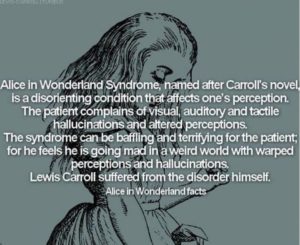Alice in Wonderland Syndrome (AiWS), also known as Todd’s syndrome or dysmetropsia, is a disorienting neuropsychological condition that affects perception. People may experience distortions in visual perception such as micropsia (objects appearing small), macropsia (objects appearing large), pelopsia (objects appearing to be closer than they are), or teleopsia (objects appearing to be further away than they are). Size distortion may occur in other sensory modalities as well.
The syndrome is sometimes called Todd’s syndrome, in reference to an influential description of the condition in 1955 by Dr. John Todd (1914-1987), a British Consultant Psychiatrist at High Royds Hospital at Menston in West Yorkshire. Todd discovered that several of his patients experienced severe headaches causing them to see and perceive objects as greatly out of proportion. They have altered sense of time and touch, as well as distorted perceptions of their own body. Although having migraine headaches, none of these patients had brain tumors, damaged eyesight, or mental illness that could have caused similar symptoms. They were also all able to think lucidly and could distinguish hallucinations from reality, however, their perceptions were skewed.
Since Lewis Carroll had been a well-known migraine sufferer with similar symptoms, Todd speculated that Carroll had used his own migraine experiences as a source of inspiration for his famous 1865 novel Alice’s Adventures in Wonderland. Carroll’s diary reveals that in 1856 he consulted William Bowman, an eminent ophthalmologist, about the visual manifestations of the migraines he regularly experienced. Since Carroll had these migraine symptoms for years before writing Alice’s Adventures, it seemed reasonable that Carroll had used his experiences as inspiration.
AiWS is often associated with migraines, brain tumors, and psychoactive drug use. It can also be the initial symptom of the Epstein–Barr Virus (see mononucleosis). AiWS can be caused by abnormal amounts of electrical activity resulting in abnormal blood flow in the parts of the brain that process visual perception and texture.
Anecdotal reports suggest that the symptoms are common in childhood, with many people growing out of it in their teen years. It appears that AiWS is also a common experience at sleep onset and has been known to commonly arise due to a lack of sleep.
Signs and symptoms
AiWS is often associated with migraines. AiWS affects the sense of vision, sensation, touch, and hearing, as well as one’s own body image. Nausea, dizziness, and agitation are also commonly associated symptoms with Alice in Wonderland Syndrome.
Individuals with AiWS can experience hallucinations or illusions of expansion, reduction or distortion of their own body image, such as microsomatognosia (feeling that their own body or body parts are shrinking), or macrosomatognosia (feeling that their body or body parts are growing taller or larger). These changes in perception are collectively known as metamorphosias, or Lilliputian hallucinations.
People with certain neurological diseases have experienced similar visual hallucinations. These hallucinations are called “Lilliputian”, which means that objects appear either smaller or larger than reality.
Patients may experience either micropsia or macropsia. Micropsia is an abnormal visual condition, usually occurring in the context of visual hallucination, in which the affected person sees objects as being smaller than they are in reality. Macropsia is a condition where the individual sees everything larger than it actually is.
One 17-year-old man described his odd symptoms by the following: “Quite suddenly objects appear small and distant or large and close. I feel as [if] I am getting shorter and smaller ‘shrinking’ and also the size of persons are not longer than my index finger (a lilliputian proportion). Sometimes I see the blind in the window or the television getting up and down, or my leg or arm is swinging. I may hear the voices of people quite loud and close or faint and far. Occasionally, I experience attacks of migrainous headache associated with eye redness, flashes of lights and a feeling of giddiness. I am always conscious to the intangible changes in myself and my environment”.
Although a person’s eyes are normal, they will often ‘see’ objects as the incorrect size, shape or perspective angle. Therefore, people, cars, buildings, houses, animals, trees, environments, etc., look smaller or larger than they should be. Further, depth perception can be altered whereby perceived distances are incorrect. For example, a corridor may appear to be very long, or the ground may appear too close.
Zoopsias is an additional hallucination that is sometimes associated with Alice in Wonderland Syndrome. Zoopsias involves hallucinations of either swarms of small animals (e.g. ants and mice etc.), or isolated groups of larger animals (e.g. dogs and elephants etc.). This experience of zoopsias is shared in a variety of conditions, such as delirium tremens.
The person affected by Alice in Wonderland syndrome may also lose a sense of time, a problem similar to the lack of spatial perspective. Time seems to pass very slowly, akin to an LSD experience. The lack of time and space perspective also leads to a distorted sense of velocity. For example, one could be inching along ever so slowly in reality, yet it would seem as if one were sprinting uncontrollably along a moving walkway, leading to severe, overwhelming disorientation.
Sufferers of Alice in Wonderland Syndrome can often experience paranoia as a result of disturbances in sound perception. This can include amplification of soft sounds or misinterpretation of common sounds.
In addition, some people may, in conjunction with a high fever, experience more intense and overt hallucinations, seeing things that are not there and misinterpreting events and situations. Less frequent symptoms sometimes described in Alice in Wonderland Syndrome patients include loss of limb control and dis-coordination, memory loss, lingering touch and sound sensations, and emotional instability.
It has been noted that patients are often reluctant to describe their symptoms due to fear of being labeled with a psychiatric disorder. It is usually easy to rule out psychosis as those with Alice in Wonderland Syndrome are typically aware that their hallucinations and distorted perceptions are not ‘real’, and they have not lost touch with reality. Furthermore, younger patients who frequently experience Alice in Wonderland syndrome may struggle to describe their unusual symptoms, and thus, it is recommended to encourage children to draw their visual illusions during episodes. It appears that the symptoms of AiWS do not change in severity over the course of the syndrome, and though the symptoms may acutely impact the patient’s life, Alice in Wonderland syndrome typically resolves itself within weeks or months. Furthermore, AiWS symptoms occur transiently during the day for short periods of time, with most patients describing their symptoms as lasting anywhere between 10 seconds to 10 minutes. This, combined with the typically short duration of the syndrome, suggests that Alice in Wonderland Syndrome typically causes a relatively short-term disruption of normal functioning. However, symptoms can be debilitating when experienced, and the individual should exercise caution, for example when driving, as the symptoms can appear rapidly. Symptom severity influences whether or not the individual will be able to hold a job during these periods of misperception.
Come back tomorrow for Part II on Alice in Wonderland!


